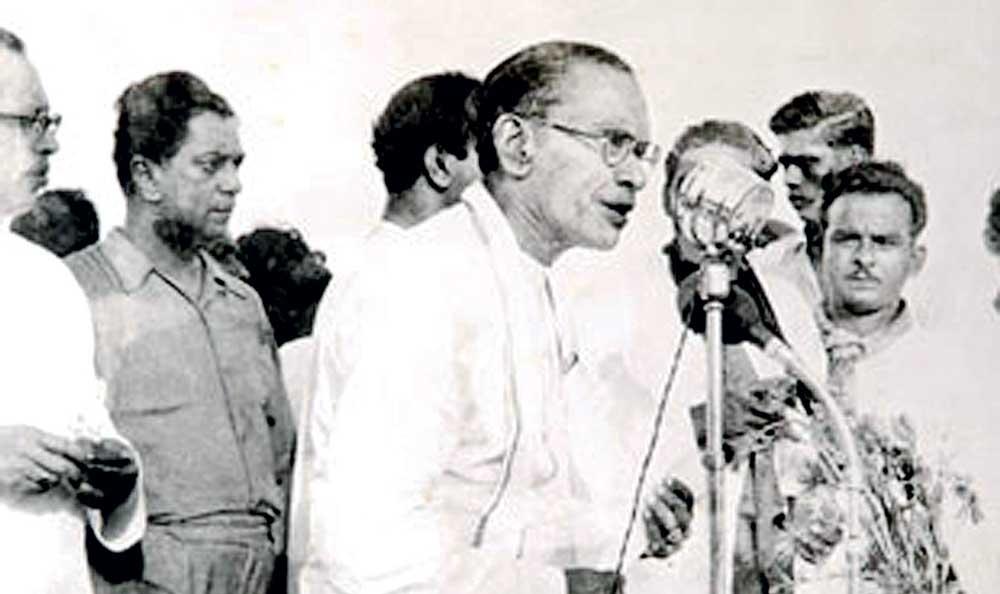Reply To:
Name - Reply Comment

Former Prime Minister S.W.R.D. Bandaranaike left the UNP to form the new party, SLFP, on September 2, 1951
| Once a dominant force, the SLFP now faces the threat of extinction, with some members joining the SJB and majority absorbed by UNP |
| The saddest aspect of the SLFP’s decline is that its ultra-nationalist stance, once a cornerstone of its identity, has been entirely co-opted by its splinter group, the Rajapaksa-led SLPP |
| Under Sirisena’s leadership, the party experienced internal conflicts and ethical splits that led to a significant decline in its influence and cohesion, resulting in fragmentation |
 The Sri Lanka Freedom Party (SLFP) was established on September 2, 1951. S.W.R.D. Bandaranaike left the United National Party (UNP), following his resignation from both his Cabinet portfolio and the UNP’s unofficial deputy leadership in July 1951, to form the new party. From its inception, the party forged a close association with nationalist and chauvinist Sinhala groups, building its foundation on a ‘Sinhala-Buddhist’ identity and cultural traditions. This strategy proved successful, leading to the defeat of the UNP in the 1956 elections.
The Sri Lanka Freedom Party (SLFP) was established on September 2, 1951. S.W.R.D. Bandaranaike left the United National Party (UNP), following his resignation from both his Cabinet portfolio and the UNP’s unofficial deputy leadership in July 1951, to form the new party. From its inception, the party forged a close association with nationalist and chauvinist Sinhala groups, building its foundation on a ‘Sinhala-Buddhist’ identity and cultural traditions. This strategy proved successful, leading to the defeat of the UNP in the 1956 elections.
The strained relations between D.S. Senanayake and Bandaranaike arose from Senanayake’s plan to make his son, Dudley, his successor. Bandaranaike, a sharp politician sensed he was sidelined, and wanted a Deputy Prime Minister’s post to secure his succession — a move Senanayake rejected.
Under Maithripala Sirisena’s leadership, the SLFP, a party that held power for more than three decades and was widely recognised for its rich history engrained in backing a socialist economic programme, experienced internal conflicts and ethical splits that led to a significant decline in its influence and cohesion, ultimately resulting in fragmentation. The SLFP’s struggles reflect broader challenges in its inability to maintain its traditional base while adapting to new political realities. As various factions and splinter groups emerged, the SLFP struggled to present a unified vision.
The SLFP suffered its most significant blow when the Rajapaksas broke away, taking a large portion of the party membership with them to form the Sri Lanka Podujana Peramuna (SLPP). This division has cast serious doubt on the SLFP’s future role in Sri Lanka’s political landscape. Once a dominant force in shaping the nation’s direction, the SLFP now faces the threat of total extinction, with some members joining the SJB and the majority being absorbed by the UNP. The party lacks a dynamic leader capable of reconciling internal differences, rebuilding its identity, and reasserting its relevance in an increasingly competitive political environment. This disintegration underscores the broader challenges traditional political parties face in adapting to evolving voter expectations and the shifting dynamics of power in the country.
The saddest aspect of the SLFP’s decline is that its ultra-nationalist stance, once a cornerstone of its identity, has been entirely co-opted by its splinter group, the Rajapaksa-led SLPP. This transfer of ideology has effectively stripped the SLFP of its former political identity, leaving the party a shadow of its former self. The remaining SLFP members, in an effort to stay relevant, have distanced themselves from the party’s past associations with racism and chauvinism. This distancing has led them to align with Wickremesinghe’s Sirikotha, a move that signifies both a departure from their traditional base and an attempt to reinvent the party in a more moderate, inclusive light. However, this transition also reflects the party’s struggle to find a new identity in a rapidly changing political landscape, where old alliances are being reshuffled, and former powerhouses like the SLFP and SLPP are fighting for survival.
A distinguished reader from the US responded to this writer’s piece last Thursday in another newspaper, incorporating little known historical facts about the birth of SLFP. Excerpts of his response are reproduced here:
“I am domiciled in the United States. … Let me add some ‘not well-known information’ about the formation of the SLFP in 1951 that my father (D.W. de S. Gamage) and Mr. T.B. Illangaratne (whom I knew from the time I was 6 or 7 years) confided in me. … When S.W.R.D. Bandaranaike crossed over to the opposition in July 1951, a group of political activists met in Kandy to discuss the development. The Central Committee of the Kandy Socialist Front in which Kurunegala Independent Socialist Parliamentarian H. Sri Nissanka who was the President, T.B. Illangaratne and D.W.de S Gamage, the Joint Secretaries, and others met at the residence of T.B.H. Godamunne, the owner of the Sithumina Bookstore in Kandy (residence known as the Sithumina Salaawa) to discuss this unusual development. …
At this ‘session’, Sri Nissanka proposed that the opportunity has come to launch a ‘national political party’ and that it should be led by Mr. Bandaranaike. Almost all the Members of the Kandy Socialist Front Central Committee, including my father and Mr. Illangaratne who were liberal-socialists (not Trotskytes or Marxist Communists) opposed saying that it was difficult to be in a political party under a ‘reactionary’.
Mr. Sri Nissanka, who was a recognised Queen’s Counsel at that time and was serving in the Legislature with Mr. Bandaranaike, then proposed to have a dialogue with S.W.R.D. to exchange views. Mr. Bandaranaike was invited to meet with the Socialist Front Central Committee members in Kandy. The members were convinced of the ‘sincerity’ of Mr. Bandaranaike, and decided to launch a national political party under the leadership of S.W.R.D.
After several more policy discussions, a session was held again… to form the political party. The ‘name’ of the party was discussed: most of the Socialist Front Central Committee members, who were liberal-socialists, proposed names that sounded Marxist-Socialist. Mr. Bandaranaike had explained that the UNP was a ‘right-wing’ party and there were two parties (LSSP/CP) to the extreme left. He proposed that if a new party is formed, it should be ‘free’ from both the ‘right’ and the ‘left’: The party was named Sri Lanka Freedom Party.
Then the symbol of the party: many suggested symbols closely associated with Socialism/Marxism. S.W.R.D. said, ‘Let’s take Lord Buddha’s HAND as the symbol’. Then the ‘party colour’: many suggested ‘Red’ but S.W.R.D. suggested blue.
The Minute Books of all these sessions were written by both Mr. Illangaratne and my father as Joint Secretaries – signed by them (and Socialist Party President, Sri Lanka) - and later years my father who possessed all these documents were handed over to Mr. Premadasa Udagama, (onetime Secretary of the Ministry of Education) at the request of Mrs. Sirimavo Bandaranaike to store at the SLFP archives. …
The inaugural meeting of the SLFP was held on September 2, 1951 at the Colombo Town Hall. …
…I am a retired Foreign Service National Political Specialist of the U.S. Department of State and was attached to the Political Section of the American Embassy in Colombo. – Daya Gamage”.
While D.A. Rajapaksa from the South remained loyal to Bandaranaike after the historic crossover, Bernard Aluvihare of Matale — grandfather of the current Aluvihare brothers — returned to the UNP just before the 1956 General Election. However, he lost his stronghold to Nimal Karunatillake, a young journalist fielded by the S.W.R.D.-Philip alliance. This defeat, the first result announced in 1956, set the tone for the UNP’s exit.
Crossovers and last-minute side-switching have occurred in the past, often based on principles, though less frequently and not merely to secure a seat in the next Parliament. However, the current trend of political “summersaults” — where individuals switch parties for personal or electoral gain — is widely seen as a shameless manoeuvre lacking in principle and integrity. These actions disregard core values and undermine the credibility of political leaders, who often stage colourful events to celebrate agreements and form “broad alliances” driven by self-serving motives rather than principled decisions.
The author can be reached at: [email protected]